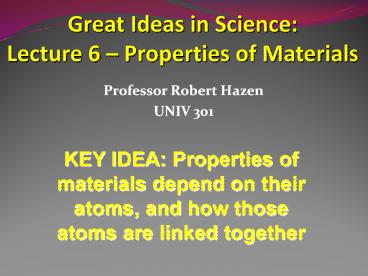Professor Robert Hazen UNIV 301 KEY IDEA: Properties of - PowerPoint PPT Presentation
Title:
Professor Robert Hazen UNIV 301 KEY IDEA: Properties of
Description:
Professor Robert Hazen UNIV 301 KEY IDEA: Properties of materials depend on their atoms, and how those atoms are linked together Chemical Reactions: Polymerizaton ... – PowerPoint PPT presentation
Number of Views:24
Avg rating:3.0/5.0
Title: Professor Robert Hazen UNIV 301 KEY IDEA: Properties of
1
Great Ideas in ScienceLecture 6 Properties of
Materials
- Professor Robert Hazen
- UNIV 301
KEY IDEA Properties of materials depend on their
atoms, and how those atoms are linked together
2
Tonights Outline
- Review Chemical Bonding
- Chemical Reactions
- Properties of Materials
- States of matter
- Changes of state
- Strength of materials
- Magnetic properties
- Electrical properties
3
Chemical Bonding
- Key Idea Atoms link together by the
rearrangement of their electrons - 1. Magic numbers of electrons (i.e. 2, 10, 18
and 36) form very stable atoms. - 2. Electrons may be transferred or shared to form
stable bond - 3. Ionic, metallic and covalent bonds
4
Ionic Bonding
5
Ionic Bonding
Ionic Bonding
Na
Cl
6
Ionic Bonding
7
Ionic Bonding
Mg 2Cl
MgCl2
Mg 2Cl
8
Ionic Bonding
9
Metallic Bonding
10
Metallic Bonding
11
Covalent Bonding
12
Covalent Bonding
Hydrogen
13
Covalent Bonding
14
Covalent Bonding
WATER
15
Covalent Bonding
16
Covalent Bonding Carbon
CARBON BONDING Organic Chemistry
17
(No Transcript)
18
Covalent Bonding Carbon
CARBON BONDING Organic Chemistry
19
States of Matter
20
SOLIDS(fixed volume and shape)
- Crystal regular atomic arrangement
21
SOLIDS(fixed volume and shape)
Glass Atoms not periodic
22
Glass vs. Crystal Structure
23
Solids Plastics
Plastics Formed from chains of molecules
24
Plastic Recycling
25
LIQUIDS (fixed volume, variable shape)
26
LIQUIDS (fixed volume, variable shape)
Liquid Crystals Molecules line up under an
electric field
27
GAS (variable volume and shape)
28
PLASMA (Gas with free electrons)
By far the most abundant state of matter in
the universe!!!
29
Changes of State
HYDROCARBONS
30
Distillation (Fractionation) Column
- Gasoline, kerosene, diesel fuel, asphalt tar
are distilled from crude oil.
31
Chemical Reactions Oxidation Reduction
32
Chemical Reactions Oxidation Reduction
Rusting Oxidation
Smelting Reduction
33
Chemical ReactionsAcid Base Reactions
34
Chemical Reactions Polymerizaton
Depolymerization
- Addition Polymerization
35
Chemical Reactions Polymerizaton
Depolymerization
- Condensation Polymerization
36
Materials and the Modern World
- Materials define a societys technical
sophistication - Chemists contributions
- Properties of Materials
- The kind of atoms of which it is made
- Arrangement of atoms
- Type of bonding of atoms
37
Different Kinds of Strength
- Strength
- Compressive
- Tensile
- Shear
- Elastic Limit
- Strength depends on the types and arrangements of
bonds
38
Compressive Strength(Strength against
squeezing)
- Stack of paper
- Masonry
- Wood
39
Tensile Strength(Strength against pulling)
- Wire
- Rope
- Chains
40
Shear Strength(Strength against twisting)
- Girder network
- Diamond
41
Composite Materials
- Combination of materials increases strength
- Reinforced concrete
- Plywood
- Fiberglass
42
Magnetic Properties of Materials
- Magnetic field
- Due to electrical current
- Electrons spinning
- Arrangement of atomic magnets
- Degree of alignment determines the strength of
magnetism
43
Key Idea
- Modern electronics control the flow of electrons
- Metals are conductors of electricity, while ionic
and covalently-bonded materials are electrical
insulators - Semiconductors conduct electricity under
carefully controlled conditions - Key Words
- p-type and n-type
- diode
- integrated circuit
- microchip
44
Conductors Insulators
- Electrical conductors allow electrons to flow
freely. - Electrical resistors drain some energy from an
electrical current. - Electrical insulators prevent the flow of
electricity.
45
Semiconductors
- Semiconductors neither good conductors nor
insulators - Example Silicon
46
Semiconductors Phosphorus doped
47
n-type Semiconductors
- Dope with phosphorus
- One extra electron for each P
48
Semiconductors Aluminum doped
49
p-type Semiconductors
- Dope with aluminum
- A missing electron hole
50
p-type Semiconductors
- Dope with aluminum
- A missing electron hole
51
Diodes
- A junction of p- and n-type semiconductors
- creates a one-way valve
52
The Transistor
- Transistor
- Control flow of electrons
- Emitter
- Base
- Collector
- Uses
- Cell phone
- Computer
53
The Transistor as an Amplifier
54
Microchips (Integrated Circuits)
- Complex array of p- and n-type semiconductors
- Designed with layers interconnected
55
Microchips and the Information Revolution
- New materials often lead to new technologies that
change society
56
Information
- The binary digit or bit
- Two possible answers to a simple question
- 8 bits 1 byte
- All information can be reduced to bits
- Visual information can be reduced to pixels
57
Two Developing Technologies
- Computers store and manipulate information
- Nanotechnology the future of materials science































